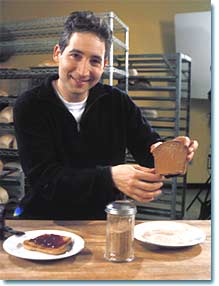Brian Greene
Brian Greene believes that he and a growing number of physicists have caught a glimpse of the answers to some of the deepest questions that physicists face today, and he wants to share them with you. In his book, The Elegant Universe, which is also a production of the PBS program Nova, Greene does a fine job of making clear many of the esoteric concepts at the heart of String Theory.
 Brian Greene uses slices of bread to help explain the characteristics of gravity on parallel universes. Image Credit: Andrea Cross/WGBH
Brian Greene uses slices of bread to help explain the characteristics of gravity on parallel universes. Image Credit: Andrea Cross/WGBHGreene and his colleagues in the forefront of String Theory believe that electrons, quarks, photons, and the other elementary particles are not infinitesimal points, as they are described by most conventional branches of physics, but instead are tiny strings that vibrate and contort in a bizarre universe of minuscule, curled up dimensions. The idea, if confirmed, links together two of the most venerable theories in physics - quantum mechanics and general relativity.
Quantum mechanics applies to phenomena on very small scales; the regime of molecules, atoms, and elementary particles. While general relativity is suited to describing the physics of massive bodies such as planets, stars, galaxies, and black holes. String Theory attempts to bridge the gap between the two fields, and may ultimately lead to a Grand Unified Theory that encompasses physics at both extremes.
The lofty goals at the heart of String Theory make it a mathematically intense field. "A lot of branches of math are invoked," says Greene, "Typically there's no one person who knows them all well." Obviously, translating the theory into a popular book or TV program is an ambitious effort. Nevertheless, to Greene, a Columbia University physicist who has made important contributions to String Theory, explaining the theory to the public is an important pursuit. "It's an interesting thing. Many science papers are written, but only a few of them really make a major impact," says Greene. "On the other hand, a popular science book can reach kids. A Nova series that can reach high school students or junior high school students, can really have a major impact on the people who might take up these ideas in the next generation. There's a certain kind of excitement about that, a certain feeling of fulfilling a very broadly relevant purpose. It's an interesting balance between the science, which can sometimes be esoteric, and these other activities, which are sometimes more tangible."
Greene himself was inspired to study physics through his visits to one of New York's popular science centers. "I grew up on West 81st Street, right across the street from the Hayden Planetarium. I have no doubt that it played a significant role in steering my thoughts in this kind of direction," says Greene. "Back then it wasn't the cutting edge kind of institution that it is today. So it had a wonderful sort of old world appeal to it in this creaky place that struck you as dedicated to trying to figure out stars and galaxies and the cosmos."
In Greene's hands, however, String Theory is anything but creaky. His book is peppered with illustrations and examples that offer an intuitive, and often humorous, interpretation of the theory's challenging mathematics. And the special-effects-laden, three-part Nova adaptation of the book, starring Greene and featuring many of the world's leading physicists, almost manages to make String Theory seem hip. Part of the program's success is no doubt due to Greene's easy going, on-screen performance. "My dad was a voice teacher and a composer," he explains, "In fact I studied singing with my dad over summers when I was in college and had a small turn of interest where I'd gotten involved in musicals."
Although Greene is a long-time admirer of Carl Sagan, who was one of the greatest science communicators of the past century, he is not certain how much time he will be able to dedicate to popular science books and programs in the future. "One thing that's become obvious to me in the last couple of years," says Greene, "is when you spend more time on one thing, you spend less time on something else. In this case, I've been able to keep my research programs at a reasonable level, but they have definitely not progressed as much as they would have without these other activities. It's a delicate balance for me, which I'm still trying to figure out how best to manage."
Greene is on the verge of releasing another popular science book, this time focusing on advances over the past centuries in our understanding of the nature of space and time. But, fundamentally, it's research that inspires him. "If I'm not actually involved in research at some significant level, I think I would get stale," says Greene. "If I were not keeping a whole side of my brain, a whole side of my being, engaged in research, it would just not feel good at all."











